51 Tips van experts over methoden voor voorraadbeheer:een methode voor voorraadbeheer kiezen, tips voor het verzamelen en analyseren van gegevens en het implementeren van een goed voorraadbeheerbeleid
Voorraadbeheer is een cruciale functie voor bedrijven in elke branche. Zonder effectieve voorraadbeheermethoden lijdt de toeleveringsketen, bent u niet in staat om adequaat aan de behoeften van de klant te voldoen, en uiteindelijk zal de bedrijfsresultaten deze tekortkomingen weerspiegelen.
Maar het kiezen van de juiste methode voor voorraadbeheer en het ontwikkelen van effectief beleid om ervoor te zorgen dat processen worden gevolgd, het verbeteren van de nauwkeurigheid van uw voorraadbeheermethoden en het verzamelen van nauwkeurige gegevens om te begrijpen hoe u die gegevens kunt gebruiken om andere delen van het bedrijf te informeren, zorgen zonder eenvoudige, algemene oplossingen.
Daarom is het evalueren van het huidige bedrijfsscenario van uw bedrijf om de belangrijkste behoeften te identificeren en systemen te kiezen en processen te ontwikkelen die het beste aan deze unieke behoeften voldoen, vaak een noodzakelijke eerste stap voor bedrijven die voor het eerst een voorraadbeheersysteem kiezen. Het is ook een goed idee voor bedrijven om deze audits periodiek uit te voeren om ervoor te zorgen dat de huidige systemen en processen adequaat zijn, rekening houdend met de groei of verandering die binnen de organisatie heeft plaatsgevonden.
Om bedrijven te helpen bij het kiezen of ontwikkelen van methoden die goed passen bij het bedrijf eisen, hebben we een lijst samengesteld met 51 tips van experts over methoden voor voorraadbeheer, variërend van informatie om u te helpen bij het kiezen van het juiste kader of de juiste methode voor voorraadbeheer tot het begrijpen van de unieke zakelijke behoeften van uw bedrijf en het creëren en handhaven van een effectief voorraadbeheerbeleid. Gebruik de onderstaande links om naar elke categorie te bladeren om door tips in een specifiek gedeelte te bladeren.
Ga naar:
- De juiste methode voor voorraadbeheer kiezen
- Basisprincipes voor voorraadbeheer
- Tips voor gegevensverzameling en -analyse voor effectief voorraadbeheer
- Uw inventaris en de behoeften van uw bedrijf kennen
- Effectief voorraadbeheerbeleid creëren
De juiste methode voor voorraadbeheer kiezen
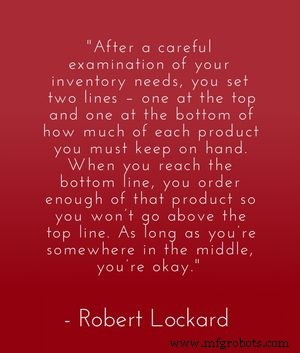
“Voors:deze methode is eenvoudig en het maakt de taak om de voorraad in evenwicht te houden vrij eenvoudig.
“Nadelen:de eenvoud ervan kan leiden tot problemen omdat je misschien te veel producten bestelt of opraakt voordat ze aankomen.” – Robert Lockard, 4 methoden voor voorraadbeheer die u moet kennen , Inventaris Systeemsoftware; Twitter:@Fishbowl
2. De ABC-methode is een van de meest gebruikte methoden voor voorraadbeheer in sommige sectoren. "Dit is een van de meest gebruikte methoden in de detailhandel en wordt soms gekoppeld aan andere methoden voor een betere controle van de voorraad. Dit is meer een techniek voor voorraadclassificatie waarbij producten worden geclassificeerd op basis van de verkoopbijdrage en het belang daarvan in hun assortimentsplan.
“A-categorieproducten zullen de maximale verkoop- en vlaggenschipproducten zijn met een hogere marge . Gewoonlijk wordt de top 20% van de producten in het assortiment die bijdragen aan 80% van de totale verkoop geclassificeerd onder A-categorie waar strikte controle op de voorraad vereist is om geen omzetverlies te garanderen. 20% van de producten die bijdragen aan 80% van de omzet, staat bekend als de 80-20-regel of het Pareto-principe
“C-Category-producten dragen uiteindelijk minder bij aan de verkoop. Deze artikelen zijn van marginaal belang voor het bedrijf en worden alleen bewaard voor het enige doel van de behoefte van de klant.
“B-Category-producten zijn belangrijk voor de detailhandelaar, maar zijn minder belangrijk in vergelijking met A-categorieproducten.” – Suresh Ram, Typen voorraadcontrolesystemen , Detailhandel in detail bespreken
3. Vendor-Managed Inventory is een optie voor sommige industrieën. “Zoals de naam al aangeeft, is vendor-managed inventory (VMI) voorraad die wordt beheerd door de leverancier (leverancier). En hoewel er meer aan de hand kan zijn, betekent dit in ieder geval dat de leverancier bepaalt wanneer hij moet aanvullen en hoeveel hij moet aanvullen.
“Door de leverancier beheerde voorraad is niets nieuws; in feite bestaat het al heel lang en komt het veel vaker voor dan je misschien denkt. Als je ooit in een restaurant hebt gewerkt, zou je de "broodman" elke dag of zo hebben zien verschijnen, je inventaris hebben gecontroleerd (fysiek kijken naar je brood, broodjes, enz.), Dan naar zijn vrachtwagen gaan en je inslaan . In een kapperszaak worden veel van de haarproducten die je kapper (ja ik ben ouderwets, ik ga naar een kapper) verkoopt of gebruikt ook beheerd door de leverancier. In dit geval is het waarschijnlijk de verkoper van dat product die de inventaris "beheert", en hij kan de kapperszaak aanvullen vanuit de kofferbak van zijn auto. Bij de oude onafhankelijke ijzerhandel werden items zoals moeren, bouten, ringen, o-ringen, enz. vaak beheerd door de verkoper. In grotere bedrijven kunt u uw verzenddozen, kantoorbenodigdheden of schoonmaak-/onderhoudsbenodigdheden laten beheren door de leverancier.” – Dave Piasecki, Vendor-Managed Inventory (VMI):wat is het en wanneer is het zinvol om het te gebruiken , InventoryOps.com
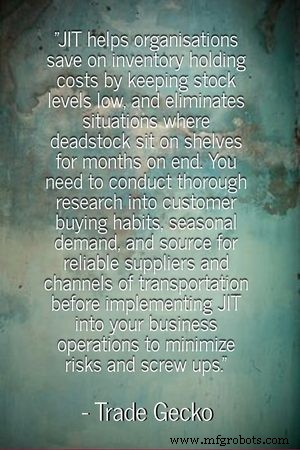
4. De Just In Time-voorraadbeheermethode wordt als een riskante praktijk beschouwd, maar het vermindert wel het voorraadvolume dat een bedrijf bij de hand heeft, wat de overheadkosten kan verlagen. “De Just In Time (JIT)-methode werkt om het voorraadvolume dat een bedrijf bij de hand heeft te verminderen. Het wordt als een riskante techniek beschouwd, omdat u de voorraad pas een paar dagen voordat deze nodig is voor distributie of verkoop koopt, zodat de artikelen net op tijd voor gebruik arriveren.
“JIT helpt organisaties te besparen op de voorraadkosten door de voorraad op peil te houden laag en elimineert situaties waarin dode voorraden maandenlang in de schappen liggen. U moet grondig onderzoek doen naar koopgewoonten van klanten, seizoensgebonden vraag en bron voor betrouwbare leveranciers en transportkanalen voordat u JIT in uw bedrijfsactiviteiten implementeert om risico's en fouten te minimaliseren." – Inventory Management Techniques , Handel gekko; Twitter:@tradegecko
5. Voorraadmethoden voor meerdere perioden hebben twee hoofdvarianten:vaste bestelhoeveelheid en bestelling met vaste tijdsperiode. “Een voorraadmodel met meerdere perioden kan twee varianten hebben. Systemen met een vaste bestelhoeveelheid zijn waar bestellingen worden geplaatst voor een vast bedrag telkens wanneer ze worden geplaatst. Het plaatsen van een bestelling wordt gedaan wanneer zich een gebeurtenis voordoet, zoals het bereiken van een minimum voorraadniveau. De tweede variant zijn modellen met een vaste tijdsperiode waarbij bestellingen op specifieke tijdstippen worden geplaatst, bijvoorbeeld wanneer er een maandelijkse herziening van de voorraadniveaus is. Het bedrag van de bestelling hangt af van de hoeveelheid voorraad die nodig is.
“De belangrijkste verschillen tussen deze modellen zijn dat er in een model met een vaste bestelhoeveelheid continu toezicht moet zijn om ervoor te zorgen dat bestellingen worden geplaatst wanneer de voorraadniveaus teruggebracht tot het juiste niveau. Voorraadniveaus in een model met een vaste tijdsperiode worden alleen gecontroleerd op het moment dat een bestelling moet worden geplaatst. In het model met vaste bestelhoeveelheid zijn de voorraadniveaus meestal hoger en dit systeem wordt meestal gebruikt voor duurdere, belangrijkere artikelen. Het vereist ook meer tijd om te onderhouden omdat voorraadmodellen constant moeten worden gemeten.
“Modellen voor vaste bestelhoeveelheid worden gebruikt in zeer stabiele situaties waar de vraag naar producten constant is, de doorlooptijd van het product bekend en betrouwbaar is, de prijs niet varieert, de bestelkosten zijn constant en alle bestellingen voor het product worden uitgevoerd.” – Peter Carr, Week 7:Voorraadbeheer , BE 603 Operations and Supply Chain Management (aangeboden door het Conrad Center for Business Entrepreneurship and Technology aan de Universiteit van Waterloo); Twitter:@UWaterloo
6. De meest effectieve methoden voor voorraadbeheer kunnen van bedrijf tot bedrijf verschillen, en zelfs voor afzonderlijke artikelcategorieën. “Voorraadbeheermethoden variëren van bedrijf tot bedrijf, van artikel tot artikel en van SKU tot SKU. De voorraadbeheermethode die het beste werkt voor langzaam bewegende artikelen, werkt mogelijk niet zo goed voor snel bewegende artikelen. Een bedrijf kan 1 miljoen verschillende SKU's hebben en slechts vijf verschillende voorraadbeheermethoden gebruiken. Eén ding om te onthouden:er is geen perfecte methode om voorraad te beheren. Een heilige graal of magische formule die resulteert in perfecte voorraadniveaus bestaat niet. Een bedrijf kan alleen zoeken naar de beste methode die resulteert in lagere kosten en hogere serviceniveaus.” – Kenneth Hamlett, Methoden voor voorraadbeheer , Chrono.com; Twitter:@HoustonChron
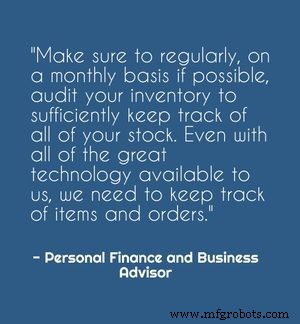
- Ten eerste kan een slecht beheerde voorraad leiden tot een onnodige verhoging van het werkkapitaal. De overtollige fondsen hadden vruchtbaar kunnen worden gebruikt om de groei-initiatieven van het bedrijf of onderzoeks- en ontwikkelingsinspanningen te voeden.
- Ten tweede zou effectief voorraadbeheer leiden tot lage opslagkosten, wat op zijn beurt zal leiden tot een toename van de winst van het bedrijf. Opslagruimte is duur; als u uw inventaris goed kunt beheren en de hoeveelheid goederen die u moet opslaan kunt verminderen, heeft u minder ruimte nodig, wat weer leidt tot lage magazijnhuurkosten.
- Ten derde kan het u helpen uw klanten tevreden te stellen door hen zo snel mogelijk de producten te bieden die ze nodig hebben. Slecht voorraadbeheer leidt tot een lagere beschikbaarheid van goederen en een hogere levertijd. Dus als u die servicetevredenheidssterren wilt behalen, moet u uw voorraad goed beheren.
- Ten vierde kunnen goederen die gedurende een lange periode in voorraad zijn opgeslagen, bederven. Dit leidt tot onnodige overheadkosten bij het runnen van een bedrijf. Daarom kan goed voorraadbeheer u helpen deze kosten aanzienlijk te verlagen.
- Ten vijfde:als je voorraden verspreid over verschillende locaties hebt, heb je een goed systeem nodig om die voorraden te beheren op basis van vraag en aanbod. Met technieken voor voorraadbeheer kunt u een heel eind komen bij het beheren van meerdere voorraden." – Laran Joseph, Voorraadbeheertechnieken en hun belang , Udemy-blog; Twitter:@Udemy_Blog
- Webgebaseerd: Het hebben van een webgebaseerde oplossing is van onschatbare waarde. Dit type voorraadbeheersysteem is vaak budgetvriendelijker, biedt meer functies en is doorgaans gemakkelijker te implementeren.
- Mobiele voorraad: Kunt u uw voorraadbeheersysteem meenemen voor onderweg? Webgebaseerd zijn is niet genoeg, dus zorg ervoor dat uw systeem compatibel is met iPad, iPhone, Android of Windows Mobile.
- Barcode-integratie: Met barcodes kunt u fouten bij het invoeren van gegevens verminderen, voorraadbeheerprocessen versnellen en uw dagelijkse activiteiten eenvoudiger maken.
- Maateenheidconversie: Het gebruik van een systeem dat uw inkoopmaateenheid begrijpt, is vaak anders dan uw voorraadmaateenheid is van vitaal belang. U kunt uw "widget" per "case" kopen bij Acme Supply, maar u kunt diezelfde "widget" aan uw personeel verstrekken per "elke" meeteenheid. Vaak zie je een scenario waarin er 50 "elk" in één "doos" zijn die is besteld. Het is van vitaal belang dat uw voorraadbeheersysteem dit proces kent en begrijpt.
- Gegevens importeren: Als u uw gegevens in eerste instantie importeert, bespaart u uren, zo niet dagen aan het met de hand typen van al uw benodigdheden. Controleer deze functionaliteit.
- Batchprocessen: Niemand vindt het leuk om steeds dezelfde taak uit te voeren; zorg ervoor dat het systeem dat u kiest bulktransacties of bulkprocessen biedt om grote taken om te zetten in gemakkelijk uit te voeren taken.
- Cyclus / fysieke tellingen: Uiteindelijk zal de hoeveelheid benodigdheden in uw schappen niet gelijk zijn aan de hoeveelheid voor dat artikel in uw Inventory Management Software, dus Cycle Counting of Physical Counting uw benodigdheden moeten snel en eenvoudig zijn. Zorg ervoor dat het systeem dat u selecteert een snelle en gemakkelijke manier biedt om deze functies uit te voeren.
- Waarschuwingen en meldingen: Blijf automatisch op de hoogte met Low Par Alerts en andere verschillende systeemmeldingen. Niemand houdt van verrassingen en met geautomatiseerde meldingen kom je nooit meer voor verrassingen te staan." – 5 eenvoudige best practices voor geweldig voorraadbeheer , De Toolkit-groep; Twitter:@TheToolkitGroup
Basisprincipes voor voorraadbeheer
9. Uw voorraadbeheersysteem moet verschillende belangrijke elementen bevatten. “Elke onderdelenbewerking heeft een soort voorraadbeheersysteem nodig, dat de volgende hoofdelementen moet bevatten:
- Het moet het onderdelenpersoneel ruim van tevoren waarschuwen dat een onderdeel uit voorraad raakt.
- Het moet de historische aankoopprijs van een onderdeel vermelden, zodat als de prijs verandert, de manager het probleem kan onderzoeken en kan vaststellen of deze wijziging een prijsverhoging is of het gevolg is van onjuiste facturering.
- Het zou leveranciers moeten vermelden die de beste prijzen bieden.
- Het moet gebruikspercentages uit het verleden weergeven, zodat de beheerder de juiste voorraadniveaus kan bepalen.
- Er zou zo min mogelijk moeten worden geschreven, vooral door monteurs." – John Dolce, 15 tips voor het verbeteren van uw voorraadbeheer , Utility Fleet Professional; Twitter:@UtilityFleetPro
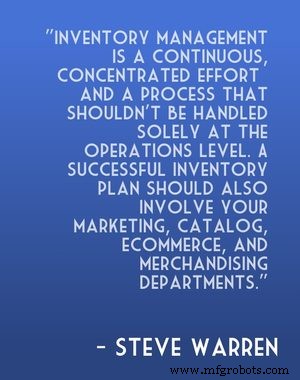
10. Maak eerst een plan en voer het dan uit. “Voorraadbeheer is een continue, geconcentreerde inspanning – en een proces dat niet alleen op operationeel niveau moet worden afgehandeld. Een succesvol voorraadplan moet ook betrekking hebben op uw marketing-, catalogus-, e-commerce- en merchandisingafdelingen.
“Door uw voorraad te beheren aan de hand van een hoofdpromotiekalender, wint iedereen:uw inkoopteam begrijpt wanneer en hoeveel product u moet kopen, uw fulfilment provider weet wanneer extra magazijnruimte moet worden voorbereid en uw contactcenterpersoneel kan anticiperen op een groter belvolume.
"Voeg verkoopprognoses van voorgaande jaren toe aan uw voorraadkalender om nog beter voorbereid te zijn op seizoenspieken in de vraag." – Steve Warren, 4 tips voor effectief voorraadbeheer , MultiChannel-handelaar; Twitter:@mcmerchant
11. Identificeer essentiële reserveonderdelen voor onderhoudsvoorraad en zorg ervoor dat ze altijd op voorraad zijn. “Heeft u uw kritieke reserveonderdelen geïdentificeerd? Kritieke reserveonderdelen =Lange doorlooptijd (4-6 weken) X Kritisch voor productieapparatuur X Hoge onderdeelkosten. Deze onderdelen zijn als levensverzekeringen. Je hoopt ze nooit nodig te hebben, maar ze kunnen maar beter op de plank liggen als je dat doet." – Verbetering van het beheer van de onderhoudsvoorraad , Marshall-instituut; Twitter:@Marshall_Inst
12. Zendingen moeten nauwkeurig worden gecontroleerd, aangezien het ontvangen van voorraad een belangrijk punt van verlies is. “Een belangrijk verliespunt is het moment van ontvangst van de inventaris. Het nauwkeurig controleren van pakbonnen voor cataloguszendingen is noodzakelijk voor voorraadbeheer. Voor het geval u een schadeclaim moet indienen, wilt u de artikelen ook zorgvuldig inspecteren voordat de rederij vertrekt. Elke zending moet nauwkeurig worden gecontroleerd, en dit omvat het tellen van producten en het vergelijken ervan met de pakbon. Afwijkingen moeten worden genoteerd en indien nodig moet een claim worden ingediend bij de leverancier die verantwoordelijk is voor de verzending." – Beheer uw inventaris , Kabbage; Twitter:@KabbageInc
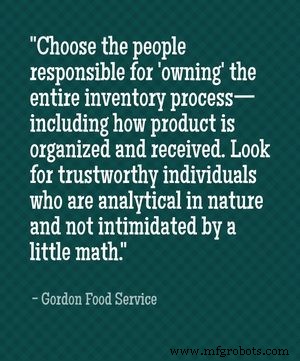
13. Wijs het juiste voorraadbeheerteam toe met de taak om de voorraadbeheerprocessen van uw organisatie te beheren. "Kies de mensen die verantwoordelijk zijn voor het 'bezitten' van het hele voorraadproces, inclusief hoe het product wordt georganiseerd en ontvangen. Zoek naar betrouwbare personen die analytisch van aard zijn en niet worden geïntimideerd door een beetje wiskunde.” – 7 tips om de voorraad van uw bedrijf te verbeteren en voedselverspilling te verminderen , Gordon Voedselservice; Twitter:@GFSDelivers
14. Net zoals voorraad één opslaglocatie moet hebben, met uitzondering van een overstocklocatie indien nodig. “Breng gelijkaardige inventaris samen in één enkele opslaglocatie. Hetzelfde onderdeel mag zich niet in verschillende opslagruimtes bevinden, tenzij de fysieke grootte een beperking oplegt. Houd in dat geval de beschikbare hoeveelheden tot een minimum beperkt en verplaats de rest naar een locatie die geen deel uitmaakt van de gemakkelijk toegankelijke opslag (overstocklocatie).” – Magazijnbeheertips voor inventarisatie van fysieke telling , riteSoft
15. Succesvol voorraadbeheer is het vinden van de juiste balans tussen de kosten van voorraad en de voordelen van voorraad. “Succesvol voorraadbeheer houdt in dat de kosten van voorraad worden afgewogen tegen de voordelen van voorraad. Veel eigenaren van kleine bedrijven begrijpen de werkelijke kosten van het dragen van inventaris niet volledig, waaronder niet alleen de directe kosten van opslag, verzekering en belastingen, maar ook de kosten van geld dat vastzit in de inventaris. Deze dunne lijn tussen het houden van te veel voorraad en niet genoeg is niet de enige zorg van de manager. Andere zijn:
- Een breed assortiment aan voorraad houden - maar de snel bewegende niet te dun spreiden;
- Verhogen van de voorraadomzet, maar zonder concessies te doen aan het serviceniveau;
- Voorraad laag houden, maar niet inleveren op service of prestaties.
- Lagere prijzen verkrijgen door volume-aankopen te doen - maar niet eindigen met langzaam bewegende voorraad; en
- Een adequate voorraad bij de hand hebben, maar niet betrapt worden met verouderde items.
“De mate van succes bij het aanpakken van deze zorgen is voor sommigen gemakkelijker in te schatten dan voor anderen. Het berekenen van de omloopsnelheid van de voorraad is bijvoorbeeld een eenvoudige maatstaf voor de managementprestaties. Deze waarde geeft een ruwe richtlijn aan de hand waarvan managers doelen kunnen stellen en prestaties kunnen evalueren, maar men moet zich realiseren dat de omloopsnelheid varieert met de functie van de voorraad, het type bedrijf en hoe de verhouding wordt berekend (of het nu gaat om verkoop of kosten van goederen verkocht). De gemiddelde omloopsnelheid van de voorraad voor afzonderlijke bedrijfstakken kan worden verkregen bij handelsverenigingen.” – Voorraadbeheer – Succesvol voorraadbeheer , IPSCMI
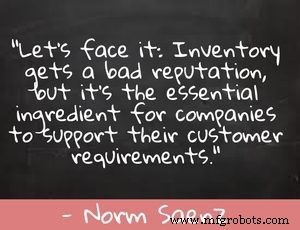
16. Voorraad krijgt een slechte reputatie, maar het is een cruciale functie voor bedrijven in bijna elke branche. "Laten we eerlijk zijn:voorraad krijgt een slechte reputatie, maar het is het essentiële ingrediënt voor bedrijven om aan hun klantvereisten te voldoen. Ze moeten hebben wat hun doelklanten nodig hebben om hun bedrijf te behouden en de concurrentie te verslaan. Dit laatste feit is de reden waarom zoveel bedrijven zeer traag bewegende of "dode" voorraden in de schappen houden.
“De voorraadvereisten bij een bepaald bedrijf variëren op basis van de vereisten voor klantenondersteuning en het type bedrijf dat een fabrikant, detailhandelaar is , groothandel of e-commercebedrijf. Zelfs binnen deze algemene kanaalcategorieën zullen er aanzienlijke verschillen zijn in voorraadbeheer in farmaceutica/drugs, voedsel, kleding, algemene goederen, auto's, elektronica, bouwmaterialen en andere soorten bedrijven.
“Terwijl de industrie en service niveaus beïnvloeden voorraadpraktijken; er zijn algemene zakelijke redenen waarom sommige bedrijven overtollige voorraad hebben, zoals het risico en de onzekerheid van de toeleveringsketen en leveranciers; variabele klantvraag en prognosenauwkeurigheid; seizoensgebonden nivellering; doorlooptijd problemen; prijsafdekking; risico om loyale klanten te verliezen; en marketing die de verkoop stimuleert met nieuwe merchandise.” – Norm Saenz, directeur bij St. Onge; Don Derewecki, senior consultant bij St. Onge, Inventory Management 101:Tijd om de principes te herzien , Logistiek management; Twitter:@LogisticsMgmt
17. Slecht voorraadbeheer is eigenlijk een symptoom van een veel dieperliggend probleem, zoals een slecht onderhouds- of facility managementplan. “Stilstand:het is een woord dat elke manager in de onderhouds- en betrouwbaarheidsbranche vreest. In de beste situaties betekent dit winstderving. In het ergste geval betekent het verlies van je baan. Hoewel niet alle problemen die downtime veroorzaken volledig te vermijden zijn, helpt het om te weten welke dat wel zijn. In deze blogpost gaan we een aantal trefzekere manieren onderzoeken om downtime uit te bannen met een paar tips voor voorraadbeheer.
“Je vraagt je misschien af wat voorraadbeheer te maken heeft met het al dan niet ervaren van downtime in een winkel , waarop ik zou antwoorden met 'veel'. Slecht voorraadbeheer is een symptoom van een veel dieper probleem, namelijk een slecht onderhouds- en/of facility managementplan.
“Een van de belangrijkste stappen voor elk onderhoudsbeheersysteem is het kennen van elk apparaat onder uw hoede. Dit omvat ook informatie over de machines, inclusief hoe oud elke eenheid is, wie de verkoper is, de contactgegevens van de verkoper, de levensverwachting van het product, voorgestelde onderhoudsprocedures... de lijst gaat maar door.
“Door te weten Met deze essentiële informatie kunt u een degelijk onderhoudsplan opstellen om ervoor te zorgen dat uw apparatuur naar behoren blijft functioneren, en zo een mogelijke toekomstige uitvaltijd te voorkomen.” – Lisa Richards, Verban uitvaltijd met deze tips voor voorraadbeheer , MapCon; Twitter:@MAPCONtech
18. Voorraadbeheer is, ondanks het belang ervan, nog steeds een functie die in sommige omgevingen, zoals de kantoren van zorgverleners, nog steeds verouderd is. “Veel kantoren hebben geen voorraadbeheersysteem en hebben daarom te maken met voorraadtekorten die het noodzakelijk maken om op het laatste moment te bestellen tegen hoge prijzen. De meeste praktijken kunnen zich niet veroorloven, of hebben niet het volume om digitale scannercontrolesystemen te ondersteunen. De kosten van inefficiëntie van artsen als gevolg van ontbrekende items zijn vaak hoger dan de kosten van de benodigdheden.
“Het volgende handmatige systeem is een eenvoudig, gebruiksvriendelijk systeem dat de controle over de inventaris in handen geeft van één persoon, terwijl nog steeds staat iedereen op kantoor toe benodigdheden te gebruiken wanneer dat nodig is zonder eerst met iemand anders te overleggen. Indien gewenst kunnen ook subsystemen worden gecreëerd voor het bevoorraden van elke onderzoeksruimte of werkplek.
“Het systeem:
- Bepaal de koopcyclus voor elk artikel (hoe vaak u ervoor gaat winkelen:wekelijks, maandelijks, driemaandelijks, enz.), afhankelijk van gebruik en opslagruimte. De meeste kantoren zouden wekelijks of maandelijks benodigdheden moeten bestellen. Als je een subsysteem hebt voor onderzoeksruimten of werkstations, dan is je cyclus van toepassing op het opnieuw bevoorraden van die ruimtes vanuit de voorraadruimte.
- Bepaal de hoeveelheid van elk item dat gewoonlijk wordt gebruikt tijdens elke koopcyclus.
- Koop in eerste instantie genoeg van elk item voor twee koopcycli en maak twee bundels van elk item. Elke bundel moet genoeg van elk artikel bevatten om één koopcyclus mee te gaan (behalve artikelen met een houdbaarheidsdatum of seizoensartikelen zoals griepvaccin). Wikkel elke bundel in met een touwtje of een rubberen band, of stop elke bundel in een aparte doos, zak of andere container. Bevestig aan elke bundel een herbruikbare tag met de naam van het artikel, de leverancier, de laatst betaalde prijs per eenheid, de koopcyclus, het bestelbedrag en het aantal artikelen van de bundel.
- Hang een envelop met het opschrift 'Envelop opnieuw bestellen' op een prominente plek. Plaats tags hier' in de voorraadruimte.
- Als er benodigdheden nodig zijn, kan elk personeelslid toegang krijgen tot een bundel, het label verwijderen en het label in de herbestel-envelop laten vallen. Er moet één volledige en één gedeeltelijke bundel overblijven voor het item dat wordt geopend.
- Wijs een voorraadbeheermedewerker aan om voorraadbeheerlabels en -labels te verwerken en nieuwe benodigdheden te bestellen volgens de koopcyclus. Bestelt uw klerk online leveringen, laat hem of haar dan controleren of de online leverancier een functie heeft waarmee nabestellingen gelijk aan een van uw bundels snel en eenvoudig kunnen worden geplaatst.
- Als de voorraden arriveren, moet de voorraadcontrolemedewerker de enige zijn die de levering opent, de leveringsfactuur vergelijkt met de originele bestelling om de juistheid te bevestigen en de artikelen opbergt.
- Herbundel artikelen en bevestig de gebruikte tag opnieuw aan de nieuwe bundel om de bestelcyclus te voltooien.
- Plaats de nieuwe bundel met artikelen achter de resterende bundel, die mogelijk al is geopend als de vraag naar een artikel onverwachts steeg (bijvoorbeeld om de voorraad te rouleren).
“Je kunt op elk moment veranderen van leverancier, inkoopcyclus, orderbedragen en bundelgrootte als dat nodig is. Pas de tags gewoon aan om de wijzigingen weer te geven." – Keith Borglum, Vraag en antwoord:tips om geld te besparen op benodigdheden en voorraadbeheer , Netwerk voor moderne geneeskunde; Twitter:@MedEconomics
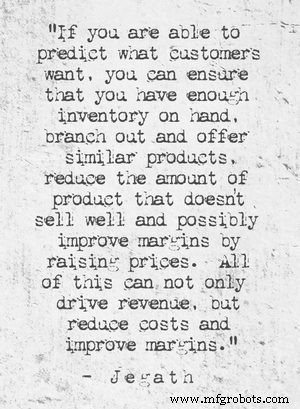
19. Kleine bedrijven mogen de noodzaak van een solide voorraadbeheersysteem niet negeren. Wanneer u methoden en softwaretoepassingen overweegt, kiest u niet voor de goedkoopste of gratis toepassing, maar voor een systeem dat met uw bedrijf kan meegroeien. "Je denkt misschien dat je, aangezien je bedrijf klein is, niet veel tijd en geld hoeft te besteden aan het bijhouden van mijn voorraad. Met de omvang van je bedrijf kun je het gewoon zelf in de gaten houden zonder dat je een speciaal systeem hoeft op te zetten.
“Deze manier van denken kan je in de problemen brengen. Voorraadbeheer omvat meer dan alleen het tellen van uw voorraad. Een goed voorraadbeheersysteem omvat ook het volgen van de voorraad terwijl deze naar klanten wordt verzonden. Door goed voorraadbeheer kunt u te weten komen welke producten goed verkopen en welke niet, zodat u weet wat u meer in voorraad moet hebben en welke artikelen u in de uitverkoop kunt nemen om ze te verplaatsen. Als u kunt voorspellen wat klanten willen, kunt u ervoor zorgen dat u voldoende voorraad bij de hand hebt, vertakt en vergelijkbare producten aanbiedt, de hoeveelheid producten die niet goed verkoopt, verminderen en mogelijk de marges verbeteren door de prijzen te verhogen. Dit alles kan niet alleen de omzet verhogen, maar ook de kosten verlagen en de marges verbeteren.
“Voorraadbeheersoftware voor kleine bedrijven kan ook helpen bij het kasbeheer. Door te begrijpen welke producten worden verkocht en dit te gebruiken om uw koopgedrag just-in-time te sturen, kunt u de conversiecyclus van contant geld voor uw bedrijf verkorten. Evenzo kunt u door producten en sku's die niet verkopen te elimineren, de hoeveelheid contant geld verminderen die vastzit in langetermijnconversieproducten. Dit alles is van cruciaal belang voor kleine bedrijven. De vraag is niet ‘heb ik een voorraadbeheersysteem nodig’ maar ‘hoeveel geld en tijd moet ik investeren’. Dan moet je ook rekening houden met groei. Later van systeem wisselen kan erg storend en pijnlijk zijn. Hoewel er gratis voorraadbeheersoftware beschikbaar is voor uw kleine bedrijf, is dat misschien niet de beste langetermijnstrategie. Koop liever een dienst of product die met je mee kan groeien.” – Jegath, Tips voor eigenaren van kleine bedrijven:meer inkomsten genereren met software voor voorraadbeheer voor kleine bedrijven , Ordoro-blog; Twitter:@ordoro
20. Voor onderhoudsorganisaties is het gemakkelijk om in de val te lopen door te denken dat het juiste CMMS ook de uitdagingen van het bedrijf op het gebied van voorraadbeheer zal oplossen. Onderhoudssoftware automatiseert en vereenvoudigt echter alleen processen die al effectief zijn. “Effectief voorraadbeheer is een van de beste manieren om de ROI van uw CMMS-implementatie te versnellen. Voorraad bijhouden kan echter een complexe en ontmoedigende taak zijn. Organisaties moeten een verscheidenheid aan apparatuur volgen, evenals de reserveonderdelen en gereedschappen die worden gebruikt om die apparatuur goed te onderhouden.
“Organisaties moesten lange tijd het voorraadbeheer handmatig doen. De moeilijkheid om voorraad in verschillende hoeveelheden en met verschillende kenmerken te volgen, wordt vergroot wanneer handmatige procedures worden gebruikt. Een voorraadbeheermodule kan het voorraadbeheer vereenvoudigen door een betere administratie en geautomatiseerde rapportage. Helaas worden voorraadbeheermodules vaak onderbenut.
“Veel onderhoudsmanagers gaan er ten onrechte van uit dat voorraadbeheer een automatische functie is van onderhoudsbeheersystemen, maar onderhoudssoftware kan alleen een proces vereenvoudigen en automatiseren dat al effectief is.” – Carol Owens, Tips om voorraadbeheer te vereenvoudigen met onderhoudsbeheersoftware , Business-Software.com; Twitter:@BiznessSoftware
21. Welke inventarisatiesystemen, -methoden en -beleid u ook gebruikt, zorg altijd voor een back-upplan om de waardevolle gegevens van uw bedrijf te beschermen. “Bescherm al je harde werk. Zelfs het meest hightech, georganiseerde voorraadsysteem kan catastrofaal ontsporen, tenzij je een back-upplan hebt. Wat als bijvoorbeeld uw ultramoderne computer wordt gestolen of een brand uw faciliteit beschadigt en uw schriftelijke gegevens tot een ashoop degradeert? Voorkom dit rampscenario door ook elders een back-up van je systeem te maken, misschien zelfs op een verwisselbare USB-stick.” – Stephanie Howard, Tips om controle te krijgen over uw managers, leveranciers en inventaris , Groov; Twitter:@GroovvSolutions
Data Collection and Analysis Tips for Effective Inventory Control
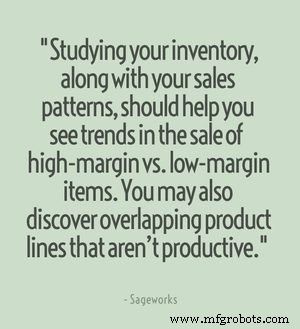
22. Find a way to evaluate what products are moving and what products are not. “One of the first ways to use your inventory information is to examine by product what is moving and what isn’t. Doing this on an ongoing basis will help identify products that may need to be discounted in order to replace them with faster selling items or in order to generate some cash. Studying your inventory, along with your sales patterns, should help you see trends in the sale of high-margin vs. low-margin items. You may also discover overlapping product lines that aren’t productive.” – Sageworks, 6 Tips to Improve Inventory Management , Funding Gates; Twitter:@FundingGates
23. Measurement is essential. You cannot control what you don’t measure. “Metrics are essential to a well-run supply chain. Metrics for their own sake, however, are worthless. The purpose of a metric is to drive change when the variable you are measuring trends in the wrong direction.
“A number of different metrics are useful for inventory management. Days supply by product and location based upon forecast is an excellent metric at the SKU level.
“When analyzing roll-up numbers for a product line, warehouse, or any other higher level, however, days supply is misleading because the lows cancel the highs and hide imbalances. At the higher level, inventory velocity is a much better measure of inventory health.
“No metric is useful, however, unless it is acted upon. Constant vigilance and early response to imbalances are the keys to ensuring best-practice inventory management.” – Jane B. Lee, 8 Common-Sense Rules for Inventory Management , Inbound Logistics; Twitter:@ILMagazine
24. Calculate your total costs. “It goes without saying that getting your inventory levels right is imperative, but what about the right quantities of your highest-performing brands and products? Maximizing sales of the goods with the most attractive margins can sometimes be tricky because of quantity discounts, special orders, and changes in wholesale prices (that you might not be aware of).
“It’s why looking carefully at total costs lets you know which products have the best margin, rather than just sell the fastest.
“Why calculate total costs?
- Focus on brands and vendors that yield the highest profits
- Find out which products perform the best by quantity margin
- Better manage discounts with a precise account of item cost” – Stephanie Braun, Fun Tips! 5 Ways To Improve Inventory Control Today , Lightspeed POS; Twitter:@LightspeedHQ
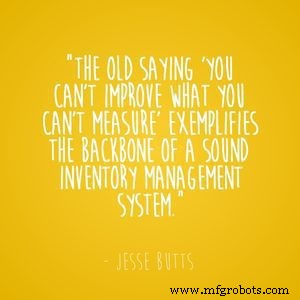
25. Track both inventory and sales data. “The old saying ‘you can’t improve what you can’t measure’ exemplifies the backbone of a sound inventory management system. If you haven’t yet started keeping thorough records, there’s no time like the present. As you create this records system, consider how it will accommodate the most vital inventory components:
- sales orders — documents comprising your customers’ purchase orders (requests for your product or service) in a format tailored for your business
- bills of materials — documents stating the inventory components (and hopefully labor) required to complete products or services
- work orders — if you’re involved in manufacturing, you’re probably familiar with these documents that include products’ details and their respective bills of materials
“You likely already have a system for recording transactions that includes sales orders (we hope). But most entrepreneurs haven’t taken the time to complete bills of materials, and for good reason:They are time-consuming. But, in the end, the benefits far outweigh the costs.
“Bills of materials are considerably easier to create for a retail storefront than for, say, a restaurant. In the food service industry, one sales order can relate to multiple bills of materials which, in turn, can require a few primary components and many others in small amounts. If you fall into the latter camp, determine the quantities of various invoice items needed for the appropriate bills of materials.” – Jesse Butts, How to Establish a Practical Inventory Management System , BizFilings; Twitter: @Toolkit
26. Check all stock inwards to account for errors in packing and other issues that may be missed if you simply assume the numbers match up. “The first focus should always be to check what actually gets delivered against what you have ordered from your supplier. It is so easy to assume that the numbers match up, but from talking to our customers we note that a good 1% to 2% of stock orders are incorrectly packed. If you just assume that you have the correct numbers of products when you add the inventory to your shelves you are liable to be short stocked when you receive a customer order. Another issue is that you might actually have more stock than you need and you won’t know when to reduce prices to move it or order more when you don’t need to.” – Stock Control and Inventory Management Tips , Cloud Fulfillment; Twitter:@CloudFulfillment
27. Centralize your data. “Regardless of how your inventory is set up physically, from a tracking perspective it should all be consolidated. This is especially the case if you have a web store and a physical one. Otherwise, you’ll appear disorganized and the process of buying could be confusing. As a bonus, being able to order online and either pick up or return in-store can seriously boost sales.” – 5 Tips for Streamlining Your Inventory Control Process , Blue Chip Inventory Service Int’l.; Twitter:@rodwalsh98
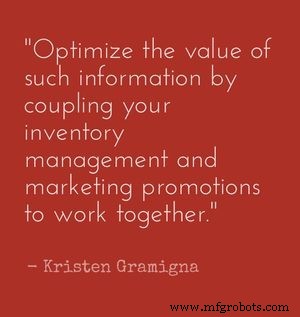
28. Inventory trends inform marketing plans. “Accurate inventory management incorporates what you know about customer and product demand from the past and present to (ideally) predict your best course of action in the future. A point of sale system can help quantify product level demand in tandem with recurring sales patterns, including those that fluctuate with some predictability (like seasonality, lifestyle occasions that impact your target audience and perhaps, local events).
“Optimize the value of such information by coupling your inventory management and marketing promotions to work together. For example, such insights can reveal potential opportunities to leverage quantity-based pricing vendors may offer, while at the same time empowering you to offset times of lower demand with promotions or ‘packaged’ deals that strategically drive sales, while moving the inventory that you acquired at a low cost.” – Kristen Gramigna, Keep Track of Your Precious Cargo:Tips for Inventory Management , Business.com; Twitter:@businessdotcom
29. Automate tracking with barcode labels and/or inventory management applications. “Another possible inventory management error is failure to track what you receive and what you sell. This can lead to losses, especially if you’re paying for products that are never showing up at your business, so some sort of tracking system is imperative. Automating the process with a barcode system and/or inventory management application is the smoothest way to handle this; note that the BizXpert app offers some useful inventory management features.
“Cycle counts are also recommended. Every day, pick a handful of items and count how many you have, comparing the number against what you have in your records. Pay special attention to big-selling and hot ticket items.” – Three Inventory Management Errors (And How to Avoid Them) , BizXpert; Twitter:@BizxpertApp
30. For many industries, including healthcare, inventory tends to follow the 80/20 rule. “Hospital inventory, like many things in life, often follows an 80/20 rule. 80% of the value of your inventory will be composed of just 20% of your actual product and most of those valuable items – whether they be assets, med-surg supplies, consignments or medication – fall into the departments of OR or Pharmacy. Plan your inventory efforts accordingly. Spend 80% of your time and energy optimizing the ordering and organization of the equipment, supplies and pharmaceutical products in these categories.” – Top 10 Tips for Hospital Inventory Management , Reliant Inventory Services
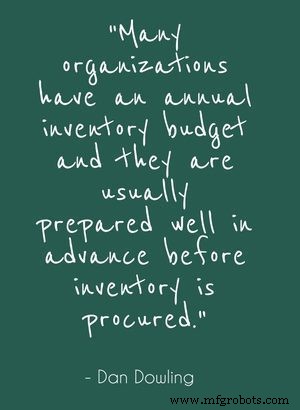
31. Inventory budgeting is a critical component of effective inventory control. “Many organizations have an annual inventory budget and they are usually prepared well in advance before inventory is procured. Budgets should include the total cost of ownership to keep inventory on hand during that year’s account period. This includes materials cost, fixed operational costs, carrying costs, logistics costs, redistribution costs and additional miscellaneous costs that contribute to the total costs of ownership.” – Dan Dowling, 6 Inventory Control Techniques for Stock Optimization , EazyStock Blog; Twitter:@EazyStock
32. When considering new inventory control software applications, be sure the cost is commensurate with functionality. “As you might expect, there are a lot of different types of inventory planning and control software out there. One of the biggest differences between many new solutions is whether they take advantage of cloud computing, or if they remain as locally installed software packages. For example, according to Inc.com , many providers of inventory control systems offer exclusively online, and full-service hybrid, versions of their software. The exclusively online versions are typically more limited in their functionality, while the full-service versions come with a higher price tag, but offer a greater number of services.” – Pat VanPutte, Inventory Control Systems Protect Your Bottom Line , NSA Computer Exchange Corp.; Twitter:@NSAComputerExch
Knowing Your Inventory and Your Company’s Needs
33. Don’t get caught with too much inventory. “Afraid of being caught short, it’s easy to spend too much on inventory, which can eat up working capital and erode profits. Warehousing isn’t free, of course, and inventory that sits on a shelf is subject to damage, depreciation, and even obsolescence. Old inventory can be very hard to move. Your options aren’t great,’ says Paul Huppertz, a logistics expert with The Progress Group, a supply chain consulting company based in Atlanta. ‘You may end up marking it down, selling to discounters, or shipping it to overseas liquidators.’
“To fix it: Start with some decent projections of how much supply you’ll need and when you’ll need it. The best gauge is what you’ve sold in the past. If you’ve sold 100 items per month for the past 12 months, chances are that you’ll need 100 this month. Then there’s seasonality:Do you usually see a fourth quarter spike with holiday sales? Or, if you’re in the home and garden business, do you see more activity in the spring selling season? ‘You can also identify and quantify less obvious patterns such as month-end spikes,’ says Huppertz.” – Lisa Girard, Five Steps to Painless Inventory Management , Entrepreneur; Twitter:@lisagjournalist
34. You should be able to break down your inventory into three basic categories:safety, replenishment, and excess or obsolete stock. “This breakdown makes it easier to make sound decisions about appropriate levels for each of these three areas. It helps determine the minimum safety stock needed to provide an insurance policy against supply chain problems either from manufacturing glitches or distribution uncertainties so that customers get what they ordered. It’s useful for pinpointing the amount of inventory required to replenish deliveries every two weeks. And it helps companies find ways to avoid a backlog of excess or obsolete inventory.” – Pratap Mukharji, Sam Israelit, Francois Faelli, Thierry Catfolis and Raymond Tsang, Ten ways to improve inventory management , Bain &Company; Twitter:@BainAlerts

35. Even with the most sophisticated automated data collection systems, a regular inventory audit is still valuable for keeping precise tabs on your inventory. “Make sure to regularly, on a monthly basis if possible, audit your inventory to sufficiently keep track of all of your stock. Even with all of the great technology available to us, we need to keep track of items and orders. This will help you to understand what is really selling and what is dead stock. Getting rid of dead stock is key to running an efficient warehouse operation. All you have to do is create a list of every product you have on your shelves – simple really.” – 5 Helpful Tips for Easy Inventory Control , Personal Finance and Business Advisor
36. Don’t be afraid to re-evaluate your company’s inventory control needs. “At what point do you realize that your approach to inventory management needs to change?
“Is it when you’re sending someone out for a 4-1/2-inch grinder and they’re gone over an hour?
“Or maybe it’s when you realize that you have hundreds of thousands of dollars—maybe millions—tied up in inventory, but you still don’t have exactly what you need the moment you need it.“If this sounds familiar, you’re not alone.“These are common practices in manufacturing environments where meeting production standards and schedules is the number-one priority, no matter what the cost. At some point, however, your finance department may recognize just how much time, money, resources and valuable shelf space is wasted on less–than–perfect inventory management practices. These days every company wants to streamline operations, improve productivity and gain that competitive edge. If you haven’t done it yet, re-evaluating your own inventory management system can help you accomplish some of these goals and significantly boost your bottom line.” – 5 Tips for Getting Started With Vendor-Managed Inventory , Grainger; Twitter:@grainger
“When each work-order status indicates the material is available, the work order is ready to go, and the maintenance planner can schedule it with the confidence that a lack of materials will not delay the job. Managers also can monitor the trend of work orders awaiting material.
“With real-time inventory control, the need for physical inventory decreases, especially if entries are accurate and complete. Out-of-stock trends can alert the stores supervisor to specific items that need expediting before they lead to equipment downtime. Managers also can monitor inventory-valuation trends efficiently.” – Thomas A. Westerkamp, CMMS:Backbone of Inventory Management and Control , FacilitiesNet; Twitter:@Maintenance_Mag
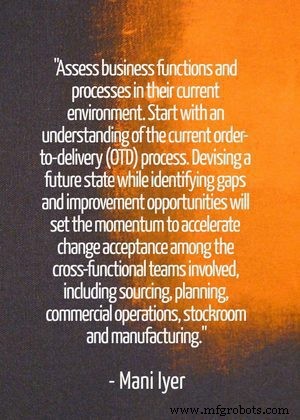
38. Conduct a business assessment. “Assess business functions and processes in their current environment. Start with an understanding of the current order-to-delivery (OTD) process. Devising a future state while identifying gaps and improvement opportunities will set the momentum to accelerate change acceptance among the cross-functional teams involved, including sourcing, planning, commercial operations, stockroom and manufacturing. Key activities in this stage should include:
- Study “As-Is” planning and execution process within the OTD process . Aim to have an unbiased assessment of current processes and practices. Start by interviewing a representative set of stakeholders who perform the same job within each function of the OTD process. Follow up with brainstorming sessions that involve key stakeholders from each function, which will help them understand their upstream and downstream process and address any issues arising out of lack of clarity of roles and responsibilities. These stakeholders should also voice their opinion on the desired “As-Is” state to establish a baseline against which improvements can be measured, and to effectively manage change through shared responsibility among their teams. Organizations should also consider conducting lean workouts among a cross-functional team of subject matter and Six Sigma process experts to understand redundant and non-value-added steps in the process due to multiple hand-offs between various functions within the OTD process.
- Summarize findings and gaps in data, process and practices. One of the ways to effectively capture the gaps in material planning and execution practices is through self-evaluation score sheets. A score sheet typically enlists the various planning and execution categories, and asks the functional owners to score according to the importance and effectiveness of each practice. Typical scoring criteria used is 1 (low), 5 (medium) and 9 (high) to clearly differentiate high impact gaps from lesser ones. For a more robust and objective view, third party service provider can also assist with benchmarking current processes against some of the best run companies in the industry.
- Devise “To-Be” planning and execution OTD process. Resource and system limitations may warrant a “To-Be Intermediate” state before moving to the ideal state. The objective is to outline a streamlined, robust and sustainable process that is aligned to the overall objective of optimizing inventory, customer service levels and variable costs. Organizations then begin to migrate to ideal state once resource and system limitations are addressed.
- Communicate to the whole group the identified improvement opportunities and goals . One of the biggest challenges faced during assessment is change resistance. Data-based inferences and identification of change catalysts is the key to driving fast adoption of more easily implemented improvements. By seeing immediate results, stakeholders will be better engaged to support additional and more sweeping process changes.” – Mani Iyer, Senior Business Manager, Genpact, Inventory Optimization:Five Steps to Improve Process Effectiveness , IndustryWeek; Twitter:@IndustryWeek
“In order to conduct proper inventory control, you must have the ability to look at past sales and predict future demand. When forecasting your demand, you must learn from your past mistakes. Previous marketing promotions must be tracked closely to measure the impact of sales increases. Understanding your sales cycle and customer buying patterns will help you gain a greater understanding of your customers.” – James Ellis of Central Oregon Community College, Inventory Control:An Essential Element of Good Customer Service , Cascade Business News; Twitter:@cascadebusnews
40. Effective inventory control can reduce harmful consequences from mishaps such as the use of outdated or expired materials, such as those used in pharmacy preparations. “Large pharmacies, especially compounding pharmacies, often produce “stores of unwanted chemicals” used in the preparation of prescriptions. These chemicals are known as “bulk compounding chemicals,” and include substances such as tar, phenol and sulfur. Between the chemicals used to prepare prescriptions, pharmacies must also keep track of the compounds and drug products that are ingredients of the final medications. Given the many materials and types of chemicals used and produced, it is especially important for managers to use chemical inventory management systems to organize and keep track of the chemicals that enter and leave a facility.
“As mentioned above, the NECC used expired ingredients in their medications, which likely exposed a number of patients to adverse effects. Additionally, chemicals were not properly labeled. Using a chemical inventory management system prevents such oversight and in all likelihood, NECC lacked such a system. For compounding pharmacies and other such companies which would greatly benefit from tracking chemical supplies, let’s examine three ways a chemical inventory management system can help improve life for both employees and customers:
- Accurate data: The FDA has promised to clamp down on compounding pharmacies as a result of 2012’s incident; however, a random inspection should not be a reason to stress when facilities have a best practices chemical inventory management system in place. Many systems have gone completely digital by using barcode labeling and even providing remote inventory control. In this way, researchers and pharmacists can easily update inventory records, thus providing accurate and real-time data on the chemicals in stock.
- Expiration no more: Expired medications can be dangerous for patients; however, monitoring the expiration dates for both the chemicals used to produce prescription drugs as well as the chemical components of these drugs can be overwhelming. With a chemical inventory management system, managers can easily monitor expiration dates remotely, thus uncovering new opportunities for saving money by ordering less of a minimally used chemical, for example.
- Promote a safety culture: The most damning evidence against the NECC was its inability to create a culture of safety, one in which clear standards and practices are present and individuals are aware of the locations and proper disposal of items. The absence of such a culture perhaps helped contribute to the contamination of medications and it is no wonder that 14 former NECC executives and technicians were indicted on federal charges related to the outbreak. By implementing a chemical management system, leaders help ensure that employees understand the importance of safety and may act accordingly to protect the interests of all.
“What occurred at the NECC proved to be a fatal flaw for the company. Though the presence of a chemical management system may not have prevented the outbreak, if such a system were in place and used in conjunction with a digital notebook capable of recording the results of sterility tests, for example, the likelihood that such a mistake could occur would have been much less.” – Lilian N., Eliminating Harmful Substances Before They Reach Patients with Chemical Inventory Management , Biovia; Twitter:@3dsBIOVIA

41. If your company must maintain inventory for equipment repairs, consider parts that can be used in a number of applications. “If you store clamps and couplings that can be used in a number of applications, you won’t need to keep as many in stock and space is reduced. Full transition couplings that fit pipes of varying types and sizes within your water or wastewater infrastructure save space and help you stay prepared for multiple scenarios. There are also products that have the versatility to either join or repair pipes.” – David Wheat, Simple Steps For Inventory Control , Municipal Sewer &Water; Twitter:@MSWmagazine
Creating Effective Inventory Control Policies
42. Creating clear policies and processes allows your company’s inventory control function to run like a well-oiled machine. “It can be an uphill battle keeping your company’s inventory effectively organized and managed. There are some subtle nuances that are easy to overlook but should ultimately not be ignored. Compass Technologies, which provides retail point-of-sale, wholesale and distribution services to its customers, offers some helpful advice for inventory and organization management.
- Limit access to inventory. Only those who need to have their hands on inventory and inventory data should be allowed access.
- Establish well defined, user-friendly storage and receipt management policies. Check lists and data tables.
- Create an inventory system that utilizes multiple locations to replenish inventory from multiple sites – minimize distribution costs.
- Clearly map and label inventory areas, easy to read and understand with item descriptions.
- Track annual and seasonal regular inventory demand analysis. Use competitive data for start-up companies.
- Track and document inventory processes, including reviews.
- Inventory data base- GP and Add-On solutions.
- Use inventory alerts to make management aware of stock limits.
- Manage paperwork, purchase orders, receipts and inventory counts with GP for reporting.
- Utilize software add-on solutions to further manage the inventory process.” – Hillary Horning, Compass Technologies, 10 Tips for Smooth and Accurate Inventory Organization and Management , ERPSoftware Blog; Twitter:@erpsoftwareblog
“Second, when working with other companies such as resellers whether it be an independent e-commerce store, a brick and mortar store or a big-box chain, a universal barcode/UPC number will be expected. A UPC number is another form of a SKU, but instead it comes in the form of a barcode which can be scanned and identified through a live database powered by GS1. Be cautious not to purchase UPC numbers from anywhere but GS1 or a valid reseller. The whole point of a barcode is to be scanned and looked up via a database, so having a barcode that brings up a different product from another company causes a lot of confusion and could potentially lose customers.
“Finally, it is always good to have a system for listing all your products specifications. Those specifications should have at least the following:
- Product Name
- SKU Number
- UPC Number
- Description
- Color
- Size
- Price
- Weight
- Dimensions (depending on product)” – Raad Mobrem, 6 Tips for Inventory Management , Small Biz Resources; Twitter:@SmallBiz_Help
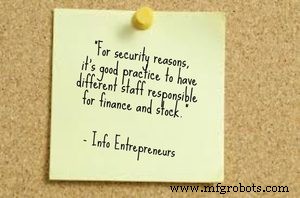
44. Dedicated inventory control managers or other administrators should be tasked with handling the administrative tasks associated with inventory control, and these roles should be separate from accounting or finance departments. “There are many administrative tasks associated with stock control. Depending on the size and complexity of your business, they may be done as part of an administrator’s duties, or by a dedicated stock controller.
“For security reasons, it’s good practice to have different staff responsible for finance and stock.
“Typical paperwork to be processed includes:
- delivery and supplier notes for incoming goods
- purchase orders, receipts and credit notes
- returns notes
- requisitions and issue notes for outgoing goods
“Stock can tie up a large slice of your business capital, so accurate information about stock levels and values is essential for your company’s accounting.
“Figures should be checked systematically, either through a regular audit of stock – stocktaking – or an ongoing program of checking stock – rolling inventory.
“If the figures don’t add up, you need to investigate as there could be stock security problems or a failure in the system.
“Health and safety aspects of stock control are related to the nature of the stock itself. Issues such as where and how items are stored, how they are moved and who moves them might be significant – depending on what they are.
“You might have hazardous materials on your premises, goods that deteriorate with time or items that are very heavy or awkward to move.” – Stock Control and Inventory , Info Entrepreneurs; Twitter:@chambremontreal
45. Make inventory accuracy a higher priority than order fulfillment. “Raising the priority of accurate inventory is perhaps the most important, yet most difficult, step in inventory accuracy. Many inventory problems arise from pushing a transaction through the system with the intent of going back and fixing the numbers later. In the rush of other emergencies, however, we often forget to go back and correct the numbers in the system. This leads to missed production entries, negative lines of inventory, and a whole mess of other problems. Only by putting systems in place that will prevent an employee from moving forward without the necessary system transaction can you effectively keep accurate records of inventory.
“One example of success that my team recently implemented was changing our accounting system so that it will not process any shipment that contains more inventory than we have on hand. For example, if we’re trying to ship 15 of an item, but our system says we only have 5 in stock, then an alert will pop up and force us to fix the problem before moving forward. This helps us address problems before the product goes out the door. By forcing us to address missed production entries before the product leaves, our modified system helped us eliminate most of our major inventory issues.” – Alex Fuller, 10 Tips to Make Physical Inventory Counts Less Painful and More Accurate , Supply Chain Cowboy
46. Inventory management software is a valuable tool and superior to outdated spreadsheet methods. “Using the right tools for the job is a must. Many companies choose spreadsheets for inventory management software because it seems like the familiar and easy thing to do. Unfortunately, spreadsheets come with built-in risks:it’s far too easy to lose changes or accidentally delete a spreadsheet file. It’s also difficult for multiple people to synchronize their spreadsheets, which further increases the risk for error. Find a low-cost but effective software for managing your inventory, such as Peachtree or QuickBooks. Most organizations overlook these options for inventory management because they’re best known for their accounting features. However, they offer invaluable inventory management software features and a central database to streamline inventory operations, increase accuracy, and minimize the possibility of error.” – 5 Supply Chain Management Inventory Tips , Women’s Distributor Services (WDS); Twitter:@WDSJennifer
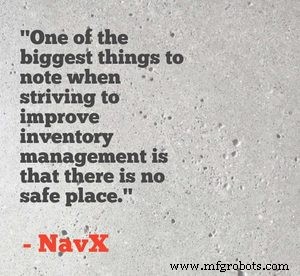
47. Optimizing inventory control requires continuous improvement. “One of the biggest things to note when striving to improve inventory management is that there is no safe place. Maintaining the right balance of inventory levels, properly organizing your warehouse for maximal efficiency, and ensuring that you have complete insight into your processes will go a long way in helping you improve effective inventory management however when you think you’ve succeeded, the worst thing you can do it sit back and relax. Taking a critical approach to operations, including inventory management, is fundamental to maintaining your competitive edge. Be sure to monitor costs as well as performance; if you see that inventory carrying costs are rising, maybe your forecasting isn’t as accurate as it could bet. If customer satisfaction falls, take a look at your order history. If you’re sending out incomplete orders, or items aren’t being sent to customers in a timely manner, dig a little bit deeper. By building the philosophy of continuous improvement into your organization and your inventory management strategy, you will be able to achieve greater efficiency and profitability.” – 3 Tips for Improved Inventory Management , NavX; Twitter:@NAVX_software
48. Cycle counts can be a useful alternative to stock-wide physical inventory counts. “Cycle-counts have become SOP with a growing number of mid-sized firms since more business software packages now provide this functionality. The benefits of employing a cycle-count regimen over periodic stock-wide physical counts are great. Cycle-counts are less disruptive to operations, offer greater specificity in determining what items should be counted and generally force greater discipline into the organization’s inventory management.” – Tips for Improved Inventory Control:Part 5/8 , TBS Automation Systems
49. Take steps to maximize both your profit and resources by involving team members and distributors in key processes. “There are many best practices that any Supply Chain Manager should follow, but a few of the strategies that tend to ensure maximizing not only profits but resources needed include:
- Working with your team and distributor to maximize service and savings; everyone should be clear on the expectations of the strategy you have defined.
- Once strategy is implemented continue consistent monitoring of purchasing behaviors. Many times a focus on efficiencies over time begins to become complacent resulting in overpayment for suppliers and an increase in overall supply chain costs.
- Understand the difference between “cost” and “price.” Many times, the manufacturer costs revealed for the savings analysis do not include the distributor mark-up, holding costs, or the freight costs. Also remember to keep in mind that being able to secure products through a manufacturer directly needs to apply to all of their products in that category, not just one of the more highly utilized items.
- Establish your ability to purchase in the lowest unit of measure. This will ensure that you are not over-ordering on products you may not use frequently or on any consistent basis.
- Be sure of what your GPO compliance requirements are. [This] includes not only volume in units, but may also include dollar-volume commitments. It is important to remember that reducing your pricing on actual supplies may interfere or require an amendment to your GPO agreement in order to maintain compliance. Many times hospitals secure agreements that include commitment to process a set dollar volume through the GPO base agreements that must be fulfilled to maximize the benefits of the entire portfolio.” – Lori Pilla, Vice President, Amerinet Clinical Advantage and Supply Chain Optimization, Amerinet Inc., St. Louis, as quoted in More inventory management best practice tips , HPN Online; Twitter:@HPN_Online, @AmerinetInc
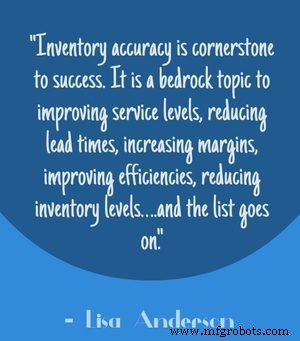
50. Follow best practices for conducting physical inventory counts. “Inventory accuracy is cornerstone to success. It is a bedrock topic to improving service levels, reducing lead times, increasing margins, improving efficiencies, reducing inventory levels….and the list goes on. Although I recommend implementing cycle counting programs as a way to replace physical inventories, there are times when a physical inventory is a must. Thus, it is worth thinking about a few tips to successfully complete a physical inventory.
- Prepare, prepare, and prepare: 80% of your success is in preparation. Organize the warehouse, clearly mark areas, label exceptions, complete and review system transactions, etc.
- Stop/isolate movement: When you begin your physical count, stop all physical and system movements and transactions. This is a critical foundation – similar to building a house, if you start adding windows prior to finishing the walls, the house might begin to fall apart.
- People and communication: Make sure the right people are in the right jobs for their skill sets. And, communicate, communicate, communicate. Make sure everyone has clear instructions, understands how to get questions answered, etc.
- Manage the control desk: This is the term I’ll use for the team organizing and controlling the process – the Grand Central Station hub. Typically, this person/team keeps track of count sheets, makes sure everything “adds up”, answers questions and keeps the process moving.
- Metrics/tracking progress: Putting the key metrics and vehicles in place to track progress is cornerstone to success. By reviewing these metrics, the leader can review progress, make adjustments as required and keep the process on track. Metrics also provide for a way to measure success.” – Lisa Anderson, Tips for Physical Inventory Success , LMA Consulting Group; Twitter:@LisaAndersonLMA
51. Give your employees tools that make them more efficient, which leads to more accurate inventory control. “Other than employees, inventory is a company’s largest asset. Reducing inventory levels and increasing inventory turns can lead to immediate savings on a company’s bottom line. Also, it’s important to consider the “landed cost” of your products. While your supplier may have a book price with bulk discounts, consider how much the product actually will cost you from the time you purchase it to the time it lands at your warehouse dock. Cargo fees, customs, and transportation add up quickly and can shrink profit margins. To navigate these challenges, consider these five tips:
- Reduce compounded safety stock: Most companies keep an extra cushion of inventory to account for unexpected demand. The problem is that when every vendor in a supply chain (raw material supplier, manufacturer, retailer) maintains that extra 5 percent to 10 percent of cushion, it adds up to unnecessary costs for each organization. The key is to communicate closely and often with your suppliers and trading partners to prevent overproduction and increased carrying cost for them. Find ways to collaborate and eliminate excess safety stock.
- Give employees tools to make them more efficient: In tough times, high-quality employees that you strive to retain can get burned out. They likely will absorb the duties of their more expendable colleagues. One way to keep them happier and more productive is to give them the technology tools that will make their jobs easier. Technology that automates tasks or offers predictive models about supply and demand will help reduce the manual aspects of their jobs, so they can focus on driving sales or broader strategies to help grow your business.
- Optimize your inventory: Simply said, you need to get rid of the inventory you don’t sell and get more of the inventory you do. The concept sounds straightforward but many small and midsize businesses have the wrong mix of inventory. While it may be painful to liquidate the inventory you spent precious resources to secure, having it take up warehouse space and require your team to manage it will cost you more in the long run. That space and mindshare could be spent on inventory that is hot and will turn over quicker, and that means more profit in your pocket. Take the short-term hit and implement a system that sheds products that don’t sell and invest in those that do.
- Focus on banner products: Growing up, there were just three kinds of soap at the grocery store:Dove, Dial, and Lava. Now a visit to the soap aisle could add another 15 minutes to a shopping trip because there are just too many choices. By adding variations to your product line versus introducing completely new and different products, you actually cannibalize your own sales and risk confusing customers to the point of apathy. Concentrate on your best products and create customer brand loyalty, which will create “customers for life” versus fickle ones.
- Manage to the future: Understand that in today’s economic climate, cash is king. If you are sitting in a good position, make cutbacks to your spending but invest in tools and people that will help you in the long run to grow your business and drive greater efficiency. With layoffs and companies eager to keep sales high, you can secure some top quality talent and excellent deals on the technology tools you need.
“In times like these, it is key to stay positive but manage realistically, cutting short-term costs that you can afford to cut. The important thing is to understand which assets are mission-critical and which ones need to be shed. Properly managing the No. 1 or No. 2 asset of your company will allow you to cut expenses and increase sales.” – Bill Harrison, Top Five Tips to Rescue Your Business with Inventory Management , AllBusiness; Twitter:@AllBusiness_com
Asset Tracking Solutions from Camcode:
- Voorraadbeheer
- Voorraadbeheer
- Aangepaste folielabels
- Magazijnborden
- Bewegwijzering
- Stainless Steel Tags
- Vloerlabels
- Beveiligingslabels
- Magnetische labels
Industriële technologie
- Mesh huidige methode en analyse
- Hoe bedrijven IoT kunnen gebruiken voor grootschalige gegevensverzameling en analyse
- Digitale transformatie 101 voor OEM's in olie en gas - 4 essentiële tips voor succes
- Toekomstperspectief:AI en data-analyse in kraanbesturing
- 4 soorten voorraadcontrolesystemen:eeuwigdurende versus periodieke voorraadcontrole en de voorraadbeheersystemen die ze ondersteunen
- 3 tips voor ziekenhuisvoorraadbeheer:processen voor het volgen van activa implementeren om voorraadbeheer te stroomlijnen
- Wat is voorraadadministratie? Hoe het werkt, soorten voorraadadministratie en meer
- Barcodes versus RFID:wat is de betere technologie voor gegevensverzameling en inventarisatie?
- 27 experts op het gebied van voorraadbeheer onthullen de nummer 1 methode voor voorraadbeheer om magazijnen geld te besparen
- Waarom gegevensverzamelingsformulieren en checklists digitaliseren?
- Belangrijkste parameters voor het kiezen van een 2-assige precisie-snijmethode



